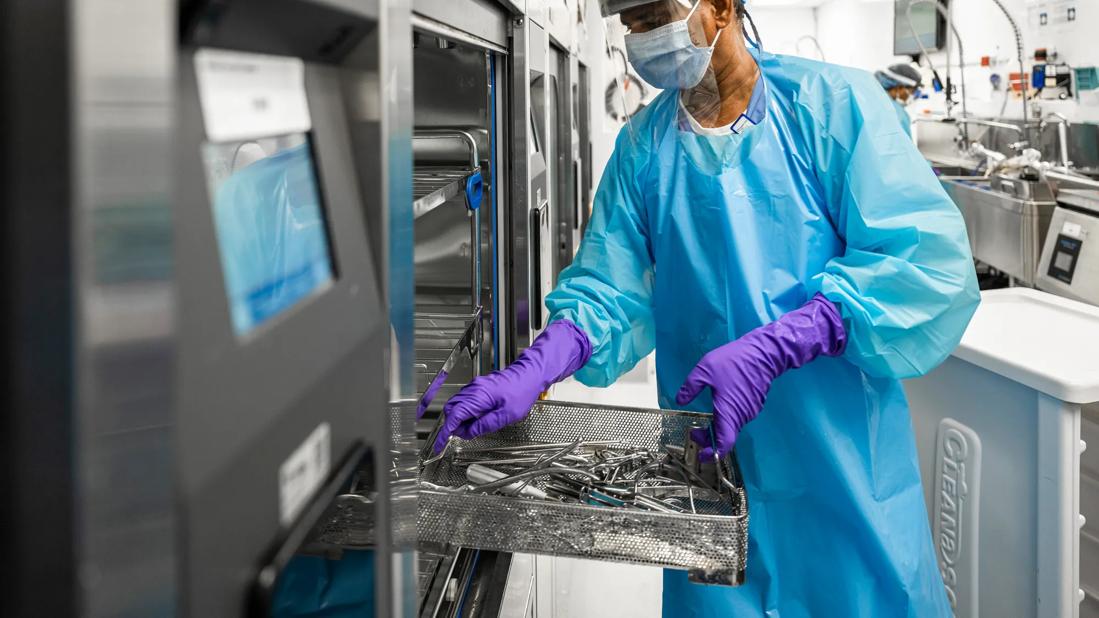Discuss safety performance, implement zero-tolerance protocols

By Carol Pehotsky, DNP, RN, NEA-BC, ACNS-BC, CPAN, Associate Chief Nursing Officer, Surgical Services
Advertisement
Cleveland Clinic is a non-profit academic medical center. Advertising on our site helps support our mission. We do not endorse non-Cleveland Clinic products or services. Policy
Serious safety events in an operating room (OR), including retained foreign bodies and wrong site procedures, should never happen. And it’s on surgical teams to ensure they don’t by creating the safest environments possible and sharing the responsibility of protecting patients.
One year ago, Cleveland Clinic OR and surgical services caregivers in Ohio and Florida recommitted and reaffirmed their pledge to patient safety. More than 800 people stood up for safety on Cleveland Clinic’s main campus while others attended virtually or at local events hosted on other Cleveland Clinic campuses. Surgical services were paused that morning so every caregiver from surgical teams could participate.
Since then, OR teams have recommitted to speaking up about potential safety events, listening to each other and using Cleveland Clinic’s Universal Protocol (UP) Safety Checklist. Surgical teams who recommit to safety in these ways can ensure the best patient safety experience in the OR.
Transparency among caregiver teams promotes consistency of care and better quality. And in the surgical setting, patient safety depends on it.
The first principle of safety is speaking up when something isn’t right. Doing so is the responsibility of every team member. The second principle is listening when someone else speaks up. Caregivers should always be intentional when providing care. Patients expect to be cared for safely. It is unacceptable for them to suffer harm.
According to The Joint Commission, the most common safety issues in the OR involve:
Advertisement
Leaders should closely monitor safety performance and talk about it with intention with their teams — openly discussing missteps, failed processes and lessons learned.
Cleveland Clinic’s Moment to Care is a good example of something we implemented because of a lesson learned. Recently, we changed our approach to the way patients are introduced to the surgical team during the first phase of the UP. We did this so the patient could be more actively involved in the initial surgical care discussion. Moment to Care has been formally incorporated into our Universal Protocol Safety Checklist to guide teams in these interactions.
The Joint Commission offers a standardized universal protocol that provides guidance for health care professionals and can be adapted for organizations. When employees are engaged in their facility’s UP Safety Checklist, harm is preventable. Safety checklists prevent and eliminate serious safety events and adhering to them keeps patients and employees safe.
Safety checklists also serve as a foundation for dialog around what needs to be done to take care of patients. They open the door for every caregiver in the room to safely comment or speak up if they are unsure about something, and to be met with an open mind. Teams excel when they share an environment of mutual trust. For an organization’s UP to be successful, employees need to commit to following it and leaders need to commit to removing any barriers that may prevent the use of it.
Cleveland Clinic’s UP Safety Checklist is how we engage our teams around safety. The use of this checklist applies to all surgical and nonsurgical invasive procedures in all inpatient and outpatient settings. It addresses the Sign In, when the surgical team initially comes together; marking of the procedure site, the Time Out immediately prior to incision; implant verification; a pause before Sign Out to ensure finalized and correct surgical counts; and Sign Out to debrief the surgery with next steps for the patient and team. Cleveland Clinic requires use of the checklist; there is a zero-tolerance policy for lack of compliance. Employees are expected to follow the UP for every patient, every procedure, every time, at every Cleveland Clinic location.
Advertisement
In 2018, Cleveland Clinic changed its checklist format from poster to paper, which has been well received by caregiving teams. Feedback from near misses and potential safety events has led to ongoing adjustments to the checklist, and two separate versions — the office-based/clinic checklist and the OR/procedural area checklist — were launched in 2022 to reflect nuances of each care setting.
There is no better time than the present to recommit OR and surgical services teams to safety. Last week, many participated in the Association of periOperative Registered Nurses’ (AORN) National Time Out Day. Each year, the day serves as a reminder of the ongoing importance of caregiving teams taking a time out to focus on the patient and prevent avoidable harm in the OR.
Those who enter healthcare do so to help others. No one intends to cause harm to patients. And there should be no room for complacency when it comes to surgical safety. Surgical professionals need to be accountable to each other and the patients they serve.
Advertisement
Advertisement

Nurse researchers explore the relationship between readmission risk scores and acute care transfers

Guiding nurses amid a constantly evolving healthcare landscape

Ideation session generates solutions to medication administration errors

Caregivers spearhead changes that improve patient care, shape hospital culture

Building a culture that supports, engages and empowers nursing staff

Nurses harness cutting-edge technology as a bridge to healing

Dedicated leader shares her passion for quality, education and professional development

Project aims to improve patient care by streamlining caregiver transitions